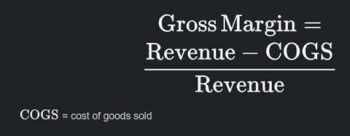- Unlock the Benefits of High Return on Equity: Learn How to Calculate ROE
- Uncover the Benefits of Using Compound Annual Growth Rate (CAGR)!
- Unpacking Collateral in Business: How it Works and What It’s Used For
- Learn How to Calculate and Use Percentage of Completion (POC): A Comprehensive Guide
- Reducing Time To Value (TTV) – How to Maximize ROI with Strategic Initiatives
Gross margin
For any business, its gross margin is part and parcel of success. Hence, why it is so important to understand and know how to measure it, both from year-end financial statements and in real time. This is one of the first potential moves and existing investors will ask.
So what is gross margin, what does it measure, and how do you track it?
What is Gross Margin?
At its most general, gross margin (or gross profit margin) is a measure of the amount of profit earned after deducting the cost of making the goods, but before taking into account other costs such as selling, general and administrative (SG&A) fees. Gross margin is derived by dividing gross profit (which is net revenue less cost of goods sold) by net revenue.
Essentially, it measures the amount of gross revenue retained, taking into account the cost of manufacturing goods/services for your business.
Gross profit is usually displayed as a percentage of your company’s income statement, after the first line of revenue and cogs. It can also be displayed as gross profit and a numerical value.
Gross margin calculation
The formula for calculating your company’s gross margin is very simple. It is:
Gross Profit * / Revenue = Gross Margin
* Gross Profit = (Revenue – Cost of Goods Sold [cogs])
To illustrate, let’s add some numbers.
If your company’s revenue is US0,000 and the cost of producing said goods or cost of goods sold (COGS) is ,000, your gross margin would be:
(250,000 – 75,000) / (250,000) = 0.7, or 70%.
Your company’s gross margin is therefore 70%.
The importance of gross margin
So why are gross margins important? Like many margins, this metric is derived by measuring one aspect of your business — in this case, gross profit — against total revenue. So, in this case, you are measuring the efficiency of your resource management, especially the manufacturing processes of your company. By comparing the net of your revenue after cost of goods sold to gross revenue, you see how much profit is lost due to the cost of your manufacturing.
In the example above, our gross margin is 70%, so we lose 30% of our revenue to the cost of making our goods.
There are several uses for gross margin, in practice. Your gross margin can tell you a lot about your business, especially compared to your peers. If your gross margin is lower than your peers, your operations can be considered more efficient – and the reverse is true if it is larger. This will force you to explore why.
Also, if your gross margin is low, it could mean that the cost of your product and/or services is too low, relative to the cost of manufacturing. This may mean that you would need to adjust the price, adjust your margins and sell your products at a higher price, for example.
A healthy business is one that has a substantial gross profit margin, which reflects operational efficiency.
Knowing your gross margin is imperative to staying on top of your business, hence the importance of maintaining an up-to-date and accurate financial model for your business to do so.
Increasing Success: Increasing Your Gross Margin
This is a big question that many businesses, from those just starting out to those looking to grow, will face. How to increase our gross margin? Ultimately, it comes down to the two components of the simple formula – your income and your inner workings. In practice, both must be addressed in order to increase your gross margin.
Increase your income and decrease your cogs.
Although it sounds simple, it may require more work and strategy than it seems.
For any start-up business, you likely pilot and evaluate different longer-term sales, product development, and customer retention strategies to determine your own industry placement as well as the segment of the market you serve and can capture. .
The details vary from industry to industry, but below are some strategies that will help you see your gross margin improvement by affecting the two aforementioned drivers (revenue and cogs).
- Increase product costs
This may take the form of increasing the cost of your products sold or increasing the price of services offered (such as subscriptions, fees). This is where evaluating the price of peers or competitors can provide a benchmark for what levels you might be looking at, as well as offers in the market.
- Increase offers
By building from the first point, you can gain an advantage in your market by offering more products or services, especially those in which your competition has not yet reached. Building more revenue streams creates more revenue, which increases your gross margin.
- Rationalization of products and costs
If there are any products that don’t perform as robustly in relation to their costs, these deserve consideration for retirement and apogee in the interests of your business. Likewise, if your company has “large” or heavy resource-consuming processes that don’t necessarily measure results, these may also be worth consideration for streamlining.
Gross margin is an essential part of your business and a vital cornerstone. Understand, monitor and stay informed with a financial model you can trust, via FinModelsLab!

